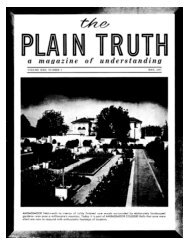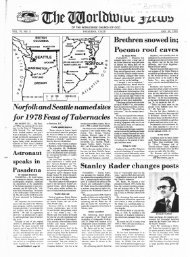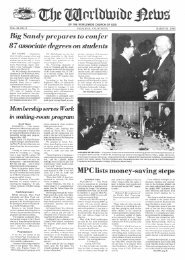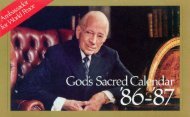The Biblical Basis of the Sacred Calendar Part One
The Biblical Basis of the Sacred Calendar Part One
The Biblical Basis of the Sacred Calendar Part One
Create successful ePaper yourself
Turn your PDF publications into a flip-book with our unique Google optimized e-Paper software.
words, "<strong>the</strong> day ended with evening, and <strong>the</strong> night with morning" (<strong>The</strong> New BDBG Lexicon, reference<br />
boqer, p. 134a). <strong>The</strong> simplest explanation <strong>of</strong> this wording is that <strong>the</strong> local day as <strong>the</strong> narrator describes it<br />
begins and ends at sunrise. Such an observer would see <strong>the</strong> evening (`erev) come twelve hours later at<br />
sunset, <strong>the</strong>n <strong>the</strong> morning (boqer) come twelve hours later still at sunrise. Whereas an observer at <strong>the</strong><br />
latitude <strong>of</strong> modern Afghanistanwould see <strong>the</strong> evening come six hours after noon, <strong>the</strong>n <strong>the</strong> morning twelve<br />
hours later, and finally noon six hours later still. However, <strong>the</strong> calendar day is being reckoned not from<br />
sunrise at <strong>the</strong> PM, nor from noon over Afghanistan, but from sunset at <strong>the</strong> IDL.32 Thus, at <strong>the</strong> latitude <strong>of</strong><br />
modern Afghanistan, an observer would experience six hours <strong>of</strong> daylight on (<strong>the</strong> calendrical) Day Zero<br />
before he begins Day <strong>One</strong>. Eighteen hours after sunset, he would reach noon on Day <strong>One</strong> just as Day<br />
Two begins at <strong>the</strong> terminator.<br />
We now go forward to verse 13: "And it came to be evening, and it came to be morning: Day Three"<br />
(literally, "a Third Day"). Day Four <strong>of</strong> Year <strong>One</strong> is about to begin at <strong>the</strong> IDL. Everywhere else in <strong>the</strong> world,<br />
Day Three has not yet ended. In Afghanistan, <strong>the</strong> local time is now 12 noon, Day Three. (It is now 6:00<br />
am on Day Three at <strong>the</strong> PM.) At this very moment -- <strong>the</strong> exact time when <strong>the</strong> cycles <strong>of</strong> "signs, appointed<br />
times, days and years" have been "set to zero" and are beginning -- <strong>the</strong> moon is in conjunction with <strong>the</strong><br />
sun, marking <strong>the</strong> very first "new moon" <strong>of</strong> Tishri (on what is now <strong>the</strong> Feast <strong>of</strong> Trumpets).33 Reasonably,<br />
<strong>the</strong> sun is also in total eclipse, marking <strong>the</strong> very first heavenly "sign" in <strong>the</strong> history <strong>of</strong> man's world.<br />
Now on what calendar day <strong>of</strong> Creation Week does <strong>the</strong> conjunction fall? On Day Three? No, on Day Four!<br />
<strong>The</strong> calendar day is reckoned from sunset at <strong>the</strong> IDL, not from sunrise at <strong>the</strong> PM or from noon over<br />
Afghanistan -- and still less from <strong>the</strong> meridian <strong>of</strong> Jerusalem (where it is still <strong>the</strong> forenoon <strong>of</strong> Day Three).<br />
About 14.7 (modern) days later, <strong>the</strong> moon is in opposition with <strong>the</strong> sun, marking <strong>the</strong> first full moon in world<br />
history. Quite possibly, it is exactly 15 days later -- for in Noah's day, a month (chodesh) had exactly 30<br />
days (cf. <strong>the</strong> chronology <strong>of</strong> Genesis 7:11-8:14). It is now noon over Afghanistan (Day 18) and sunset at<br />
<strong>the</strong> IDL (Day 19). Once again, <strong>the</strong> calendar day is reckoned from sunset at <strong>the</strong> IDL, not from noon over<br />
Afghanistan -- so this opposition occurs on Day 19 (not Day 18) <strong>of</strong> <strong>the</strong> world calendar.<br />
All this illustrates <strong>the</strong> biblical reason for Postponement Rule 2: When Molad Tishri occurs at noon or later,<br />
Tishri 1 is postponed until <strong>the</strong> next calendar day. This rule is a necessary consequence <strong>of</strong> keeping time<br />
on a round earth, if one begins <strong>the</strong> calendar day at sunset when it arrives at <strong>the</strong> easternmost "end <strong>of</strong> <strong>the</strong><br />
earth".<br />
Until about <strong>the</strong> middle <strong>of</strong> <strong>the</strong> last century, astronomical time (i.e., time as used to measure and calculate<br />
astronomical events) has always been reckoned noon-to-noon, not sunset-to-sunset. <strong>The</strong>refore, <strong>the</strong><br />
calculations <strong>of</strong> <strong>the</strong> Hebrew calendar must deal with astronomical time. Yet we know that <strong>the</strong> Hebrew<br />
calendrical day begins at sunset, and locally whenever sunset arrives at a particular place on earth. <strong>The</strong><br />
only possible explanation is that at some point in history, a Molad Tishri occurred at noon on one calendar<br />
day at a given latitude, even as ano<strong>the</strong>r calendar day began at sunset at a latitude six hours to <strong>the</strong> east.<br />
This side <strong>of</strong> Creation Week, we have no pro<strong>of</strong> as yet as to when that point in history could be. However,<br />
our Hebrew calendar does have a benchmark from which <strong>the</strong> Molad Tishri may be calculated for any<br />
given year: Sunday, October 6, 3761 B.C., 23 hours 204 parts, as converted to <strong>the</strong> common civil<br />
calendar. (<strong>One</strong> hour is comprised <strong>of</strong> 1,080 parts.) While Rabbinic Judaism considers 3761 B.C. <strong>the</strong> year<br />
<strong>of</strong> <strong>the</strong> world's creation, <strong>the</strong> Talmudic chronology upon which this supposition is based is faulty when<br />
compared with biblical indications.34<br />
In any case, we cannot justify <strong>the</strong> "noon-or-after" postponement by saying that <strong>the</strong> Sanhedrin needed at<br />
least six hours to announce <strong>the</strong> impending arrival <strong>of</strong> Tishri 1. This is an attempt to reconcile <strong>the</strong><br />
irreconcilable (a calendar based on calculation and a calendar based on observation). <strong>The</strong> Bible<br />
commands that <strong>the</strong> Feast <strong>of</strong> Trumpets be kept on one day, not two -- which proves all by itself that <strong>the</strong><br />
biblical "new moons" were set by calculation <strong>of</strong> <strong>the</strong> mean conjunction, not by observation <strong>of</strong> <strong>the</strong> new<br />
crescent. Notice by contrast that <strong>the</strong> empirical methods used by <strong>the</strong> Pharisees <strong>of</strong>ten forced <strong>the</strong> post-<br />
Temple Diaspora, and <strong>of</strong>ten even <strong>the</strong> post-Temple Sanhedrin, to keep <strong>the</strong> Feast <strong>of</strong> Trumpets over two
















